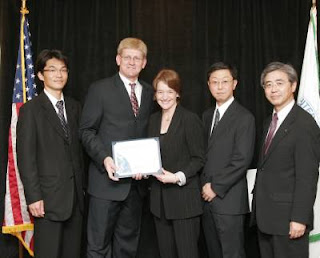
Mitsubishi Motors automotive tradition goes back to 1917 when the Mitsubishi Model A, Japans first series-production automobile, was introduced. Over the next two decades the company established themselves as an innovator, developing, amongst others, Japans first diesel engine, its first large-sized bus (the start of the world famous Fuso commercial vehicle series), its first four-wheel drive passenger car prototype, and its first diesel-powered truck.
At the end of the Second World War Japans large industrial groups were dismantled by order of the Allied powers and Mitsubishi Heavy Industries was split into three regional companies, each with an involvement in motor vehicle development.
The countrys major need at this time was for commercial vehicles, the situation being further complicated during the first few years by a severe fuel shortage. In consequence 1946 saw the introduction of a bus which could be run on either petrol or alternative fuels, and, in 1947, an electric bus; in the truck field the innovations continued with Japans first truck to be equipped with an air suspension system, as well as the first tilt-cab truck. Passenger vehicle production was confined primarily to Mitsubishis first scooter.
By the beginning of the 1960s, however, Japans economy was gearing up: wages were rising and the idea of family motoring was taking off. The Mitsubishi 500, a mass market saloon, fulfilled this need; followed, in 1962, by a four-seater micro-compact with a two-stroke air-cooled 359cc engine, the Minica - a name which still lives today. The first Colt -a larger, more comfortable family car, not a predecessor of the modern Colt - was also introduced in the same year, and the first Galant in 1969. This was a genuine pacesetter in the Japanese market, representing the best and latest in automotive technology and was to sire a long and illustrious line with a string of motor sports honours and consumer awards to its name.
With similar growth in its commercial vehicle production it was decided that the company should create a single operation to focus on the automotive industry and, in 1970, the Mitsubishi Motors Corporation (MMC) was formed.
The 1970s saw the beginning of Mitsubishis considerable international rallying success with Galants and Lancers, demonstrating the qualities of performance and reliability for which they are known today. As part of a global expansion programme in 1974 UK distribution was ensured with the formation of The Colt Car Company, a joint venture between the Mitsubishi Corporation and Colt Automotive Limited.
By the end of the decade Mitsubishi vehicles were picking up honours both at home and abroad, including South Africas 1977 Car of the Year (the Galant) and 1979 USAs Pick-up of the Year (the L200). But this was just the start. In 1982 the Shogun (named Pajero or Montero in other parts of the world) was launched, a 4x4 which was quite different from anything that had been seen before. Quite incredibly, just a few months later in the Paris-Dakar rally, it took honours in the Production Class and the Marathon Class, as well as the Best Team award. Two years later it won outright and a legend was born. The Shogun became a global best-seller, winning 4x4 of the Year awards in Britain, France, Australia, Spain and West Germany. And it was not alone on the honours list - Galants, Colts, Lancers and L200s were all being honoured worldwide.
Throughout the 1990s the Shogun continued to dominate rally events like the Dakar, and Mitsubishi vehicles also began to make their mark on the World Rally Championships. By the end of the century Tommi Makinen in a Lancer had won the Championship an historic four consecutive times whilst Lancers totally dominated the Group N Championships - for vehicles which are basically showroom standard.
Technologically this decade saw incredible advances. In 1990 MMC introduced the worlds first Traction Control System, followed by Super Select 4WD and Multi-mode ABS in 1991 and INVECS in 1992. Commercial production of the Libero electric car began in 1994 whilst 1996 saw the development of the GDI engine.
Overseas production expansion was attained with the first Carismas rolling off the line at NedCar, Holland in 1995 - a joint venture between MMC, Volvo and the Dutch government - as well as the opening of production lines in Australia and Thailand. NedCar became a wholly owned MMC facility within a year.
In 2000, MMC and DaimlerChrysler (DC) developed a business partnership that involved design, development and production co-operation. DC purchased a 37% stake in MMC and at NedCar Volvo production was replaced by Smart Four-Fours. In 2004 DCs stake in MMC was sold to the Mitsubishi Family (comprising of Mitsubishi Corporation, Mitsubishi Heavy Industries and the Bank of Tokyo Mitsubishi). However, MMC and Daimler Chrysler have maintained a successful business relationship and continue to share B & C segment platforms and engines.
In terms of motor-sport, the strength of Mitsubishis 4x4 heritage was yet again demonstrated by a record breaking 12th victory in the 2007 Dakar rally - the seventh successive victory for the Japanese manufacturer.
Today, MMC has manufacturing facilities in over 30 countries and its sales and after-sales organisation is present in more than 170 countries








